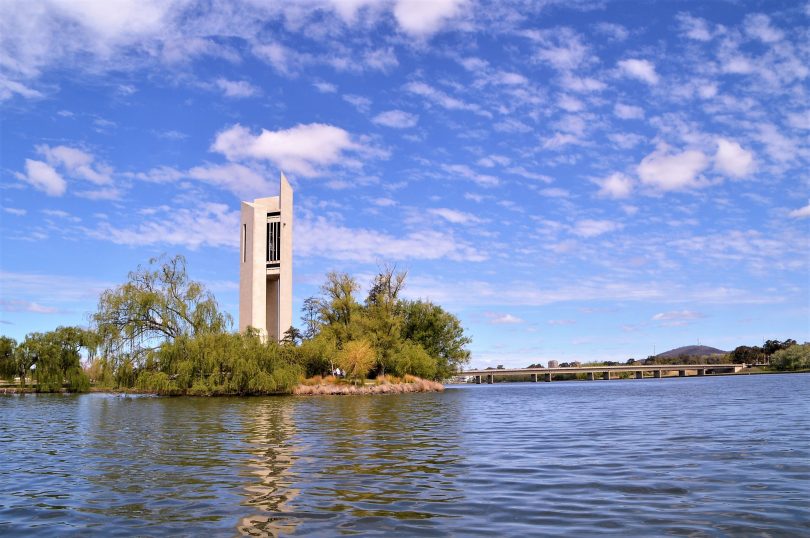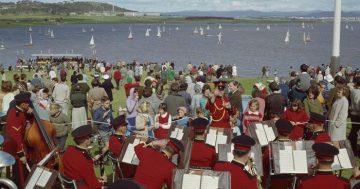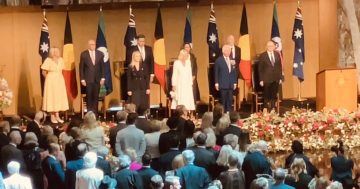
Aspen Island will be renamed in honour of Queen Elizabeth II. Photo: Glynis Quinlan.
After a statue of Andrew Ellis Clarke was unveiled on Constitution Avenue in 2020, the public conversation on the underrepresentation of women in our public memorialisation has steadily grown.
On 1 January, the Federal Government announced Aspen Island would be renamed ‘Queen Elizabeth Island’. While some might say this is a win for the commemoration of women in our public art and placenames, it shouldn’t be taken as that.
It would seem the Federal Government understands the high value of conscientious public representation, and it was encouraging to see the most recent commissioning of a bust of Marion Mahony Griffin, located at the lookout on Mount Ainslie.
Marion Mahony Griffin was a largely overlooked figure until recently, despite her significant role in developing the winning design for the city of Canberra, which was won only under her husband’s name. Marion’s former absence in our national consciousness is particularly galling when one looks to just a sample of her contributions to this nation over a distinguished career.
We now know that early on in her relationship with Walter Burley Griffin, she rendered his plans for the Australian Government’s international competition for the design of our new capital to a remarkably fine degree despite having never seen the landscape.
However, Marion was a trailblazer in many other respects. She was the first licensed female architect in her home state of Illinois. NCA curator Roslyn Hull has described Marion as “the first woman as far as we know working — that is, actually having a job — as an architect anywhere in the world”.
‘You can’t be what you can’t see’ has been the guiding creed for my work in this space these past few years. It is my strong belief that this turn of phrase is best applied when we memorialise art, places, and any other form of public commemoration after women and other marginalised groups who have achieved great things.
To get our own house in order on this issue, so to speak, I have made the case in the Legislative Assembly for better representation of women in our public memorialisation. Noting that at the time of Art ACT’s listed gendered sculptures, 16 were male, 10 of which depicted historical figures. 11 were female, of which 1 was a historical figure resulting in a 10 to 1 gender imbalance.
Shortly after this, Jasiri – organisers of ‘Girls Take Over Parliament’, launched a petition I sponsored, calling on this Government to: “look to promote equality and diversity in the people we recognize through public commemoration; increase the prominence of women in place naming conventions across the territory; and identify opportunities to increase the representation of women, especially of diverse backgrounds and First Nations leaders in our public statues.”
Consequently, the Standing Committee on Economy and Gender and Economic Equality resolved to inquire into memorialisation through public commemoration, submissions for which are still currently open.
The Minister for Arts has begun to address the disparity within the Art ACT’s collection, announcing in our most recent budget $200,000 dedicated to a new public artwork commission by a female or non-binary artist to represent and celebrate women and/or non-binary people.
We have also seen great progress in recent times from the Deputy Chief Minister, with two of our new schools named after women, taking the total from one to three. Every student who hears the name of these schools will know women can succeed in equal value to the men who have been named after schools.
This brings us back to ‘Queen Elizabeth II’ Island.
Queen Elizabeth II was born into the most powerful position of any person in the Commonwealth. While many will rightly argue that she has performed her duties in a commendable manner and is a worthy candidate for memorialisation, many others can similarly assert she already enjoys significant recognition.
We would do well to put a comparable effort into naming things after women who have not had the institutional backing it takes to be recognised for achievements which we would recognise in many of their male counterparts without fuss. If we are going to recognise and memorialise women, it should reflect the diverse contribution made by all females.
After all, names, and things that are named, have meaning. Otherwise, we wouldn’t bother naming them at all.
Suzanne Orr is the Labor Member for Yerrabi. She is a member of the standing committees on the Economy and Gender and Economic Equality and Planning, Transport and City Services, of which she is Deputy Chair.














